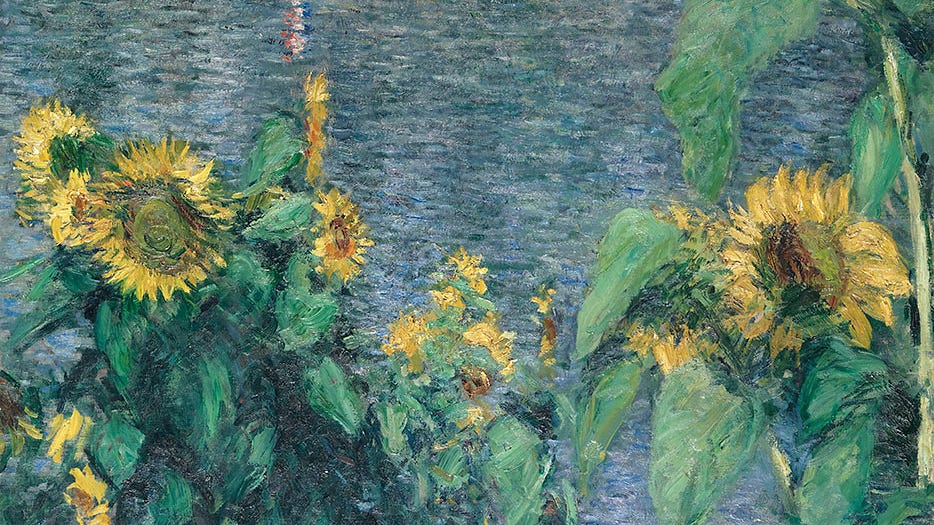Fine Arts Museums of San Francisco Receive Major Gifts of Art from the Estate of Diana Dollar Knowles
Aug 16, 2013
Gustave Caillebotte, Sunflowers along the Seine, ca. 1885–1886. Oil on canvas, 35 1/2 x 28 in (90.2 x 71.1 cm). Fine Arts Museums of San Francisco, Estate of Diana Dollar Knowles, 2013.45.3
SAN FRANCISCO (August 16, 2013)—The Fine Arts Museums of San Francisco are pleased to announce a generous bequest of three paintings from the estate of Diana Dollar Knowles: Sunflowers along the Seine (ca. 1885–1886) by Gustave Caillebotte, and Ruins with Prophet and Ruins with Sibyl (both 1731) by Giovanni Paolo Panini. These additions represent the first examples of each artist’s work to enter the collections of the Fine Arts Museums.
Sunflowers along the Seine by Gustave Caillebotte (French, 1848–1894)—currently on view in the exhibition Impressionists on the Water, at the Legion of Honor through October 13—is a dynamic composition in which a frieze of golden sunflowers dwarfs a view of sparkling water with a floating, white pavilion moored at the riverbank in the background. An accomplished sailor and boat designer, Caillebotte purchased a home along the Seine, at Petit-Gennevilliers, near Argenteuil, a popular site for regattas. The flowers, which feature prominently in this depiction, and the lively color palette Caillebotte used for this subject, suggest his passion for the garden that he cultivated there. The artist often used his garden for painting en plein air to capture the effects of radiant daylight, which are conveyed here in rhythmic brushwork across the water’s surface.
The bequest also includes two pendant paintings, Ruins with Prophet and Ruins with Sibyl, by Giovanni Paolo Panini (Italian, 1691–1765), an artist who worked in Rome and became famous for his depictions of that city. This pair of architectural fantasies, known as capricci—displayed in their original, hand-carved, Venetian frames—portray classical ruins, which the artist embellished with figures and animals. Panini received his early training from painters of theatrical scenery, developing skills that served him well in these detailed, illusionistic views. Dated in the year that Panini became a member of the French Academy in Rome, these paintings reveal the eighteenth-century taste for antiquity and picturesque ruins. This type of cabinet picture was popular with an international clientele of collectors, including those making the Grand Tour across Italy.
“We are extremely grateful to Mrs. Knowles for these exceptional additions to our permanent collection. The Paninis extend our very fine group of eighteenth-century Italian paintings, and the Caillebotte is something of a tour de force that commands attention every time you look at it,” said Colin B. Bailey, director of the Fine Arts Museums of San Francisco.
Diana Dollar Knowles was a generous supporter of the Museums and a trustee from 1986 to 1997. A passionate interest in fashion inspired her and her husband, Gorham B. Knowles, to give a significant donation in support of the textile arts galleries at the new de Young, where a room is named for them. The Louis XV period room at the Legion of Honor is also named for them in honor of a prior contribution. Mrs. Knowles was also an important patron of the San Francisco Opera, the San Francisco Ballet, Grace Cathedral, and the League to Save Lake Tahoe.
Diane B. Wilsey, president of the Museums’ board of trustees, said, “I am delighted that Diana Knowles, who was a great personal friend to me and a devoted friend to the Fine Arts Museums for so many years, has continued her tradition of philanthropy with this generous bequest to the Museums. Although she is no longer with us, she will continue to enrich our lives and the lives of future generations, for which we are very grateful.”
About the Fine Arts Museums of San Francisco
The Fine Arts Museums of San Francisco, comprising the de Young Museum in Golden Gate Park and the Legion of Honor in Lincoln Park, is the largest public arts institution in San Francisco.
The de Young originated from the 1894 California Midwinter International Exposition and became the Memorial Museum. Thirty years later, it was renamed in honor of Michael H. de Young, a longtime champion of the museum. The present copper-clad, landmark building, designed by Herzog and de Meuron, opened in October 2005. It showcases the institution’s significant collections of American painting, sculpture, and decorative arts from the seventeenth to the twenty-first centuries; art from Africa, Oceania, and the Americas; costume and textile arts; and international contemporary art.
The Legion of Honor was inspired by the French pavilion at San Francisco’s Panama Pacific International Exposition of 1915, which was a replica of the Palais de la Légion d’Honneur in Paris. The museum opened in 1924 in the Beaux Arts–style building designed by George Applegarth on a bluff overlooking the Golden Gate Bridge. Its holdings span four thousand years and include European painting, sculpture, and decorative arts; ancient art from the Mediterranean basin; and the largest collection of works on paper in the American West.
Media Contact
Maureen Keefe \ mkeefe@famsf.org
Erin Garcia \ egarcia@famsf.org
